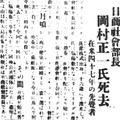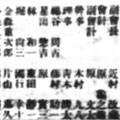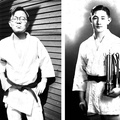In the last chapter, I introduced some notable people in Seattle's Japanese community who were featured in the column, “Ichinichi hitori hito iroiro” (One Person a Day – Let Us Introduce Them) of The North American Times in 1919. This chapter introduces some Japanese Consuls who were appointed by the Japanese Consulate in Seattle, which was established in 1901.
* * * * *
The role of the Japanese consulate was significant in its support of Japanese residents in Seattle. In chapter 1, I wrote about the establishment of the consulate in Seattle in 1901 and of the Japanese government sending 13 consuls to Seattle by 1941 (excluding acting consuls and those with other titles). The consulate in Seattle managed parts of Washington, Montana, Alaska, and Idaho.
Articles from 1917-20
Part 1 of the column, “Ichinichi hitori hito iroiro,” published in the January 1, 1919 issue, features Naokichi Matsunaga, who served as consul from 1917 as a successor to Consul Seiichi Takahashi.
With his passion and kindness, (Matsunaga) is highly regarded as one who has earned the position of a high-ranked officer. If you allow me to be frank, though, after Consul Takahashi made a mess, anyone would have been welcomed. But he is certainly not incompetent. He is committed to clerical work and gets along well with people. He is young but competent. He is flexible and has a broad perspective which is quite unlike a typical person from Saga. He maintains an even keel. He will surely make a successful career.
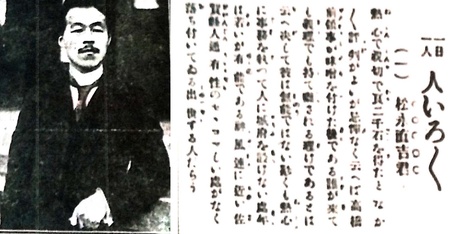
Consul Matsunaga supported the development of the Nikkei immigrant community in Seattle by working to improve the well-being of Japanese residents and to strengthen the Japan-US relationship. He passed the torch to Morinobu Hirota in March 1920 (published in the Feb. 18 and Feb. 24, 1920 issues).
Consul Matsunaga is the most popular consul of all time. He is very influenctial and respected in Seattle's Japanese community. It is regrettable to know that he will leave after three years. It's only a small deal for the Foreign Ministry, but it's a serious matter for Japanese communities in Washington State. There is nothing but to entrust hope to the new consul Morinobu Hirota.
The Japanese in the United States had high expectations for consuls. Mr. Hirota was an elite diplomat from Hiroshima Prefecture who served as a foreign secretary and secretary to the Prime Minister since 1918.
Articles after 1934
The December 21, 1934 issue published the obituary of Consul Uchiyama's daughter. According to this article, Consul Uchiyama came to Seattle with his wife and daughter in 1931. While attending a local junior high school, his daughter built close relationships with locals by introducing Japanese art in Seattle.
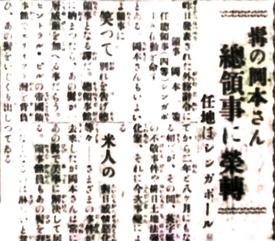
An article in the December 3, 1937 issue was about Consul Issaku Okamoto finishing his term of two years and eight months, and getting a promotional transfer as Consul General to Singapore. Consul Okamoto played an important role in resolving major issues for Japanese residents at the time of increased anti-Japanese feelings among Americans due to the Sino-Japanese War (1937-1945).
Another article, published in the December 8 issue, was about a big farewell party held for Consul Okamoto and Yoshiki Sato taking the post as new consul.
In the March 3, 1938 issue, Sumiyoshi Arima, the president of The North American Times, expressed his expectations for the new consul Sato with the headline, “Welcome Consul Sato” in a section called “Hokubei Shunjyu” (North American spring and autumn) where he wrote his post every day under the pseudonym “Ichiro Hanazono.”
The relationship between consuls and residents is one of a kind. It is different from a counterpart in their home country, the one between government officials and citizens. A consul is indeed an official who represents the government, but his position in a foreign land not only makes him a representative of the government but lets him be a leader of the residents and one who supports them and gives advice . . . In other words, he is the head of the household which consists of fellow Japanese people. . . . As one of the residents, I don’t ask for anything beyond his cooperation with other officials and the consulate. Besides, Consul Sato is an expert with years of experience. . . . If I were to request one thing though, I would hope that he will visit his fellow Japanese residents in the area and listen closely to what they have to say. This is the kind of hope a fellow Japanese from the countryside has that doesn’t get fulfilled very often whenever a new consul takes his post.
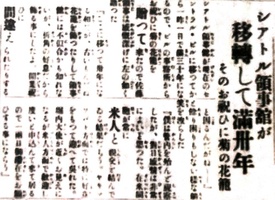
We can see how much hope the Japanese in Seattle had for consuls. In the December 3 issue of the same year, I found Consul Sato’s comment from the 30th anniversary of the Seattle Consulate move from Tacoma.
I have visited most places in our area and have the impression that Americans have very good feelings for Japan. It’s proof that our fellow Japanese residents have built a good relationship with Americans.
One wonders if Consul Sato sometimes read the “Hokubei Shunju” opinion. As if responding to the expectations stated there after taking up his position, he continuously visited the area and interacted with many Japanese residents. Consul Sato was the last consul who worked to promote goodwill between Japan and the U.S. for the sake of Japanese residents before World War II.
In the next chapter, I will write about the Yokohama-Seattle shipping route which was the cornerstone of the rapid growth of Seattle.
References
Kojiro Takeuchi, Beikoku Seihokubu Nihon Imin-shi (History of Japanese Immigrants in the Northwestern United States), Taihoku Nippo-sha, 1929.
Kazuo Ito, Hokubei Hyakunen Zakura (100-Year-Old Cherry Blossoms in North America), Nichibou Shuppan, 1969.
*The English version of this series is a collaboration between Discover Nikkei and The North American Post, Seattle’s bilingual community newspaper. This article was originally publishd on April 9, 2022 in The North American Post and is expanded for Discover Nikkei.
© 2022 Ikuo Shinmasu





